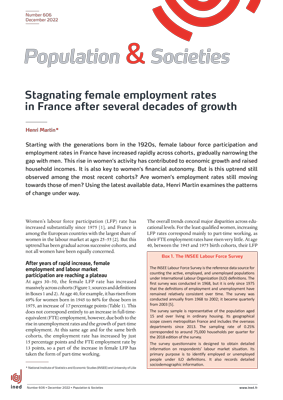Stagnating female employment rates in France after several decades of growth
Press release Published on 05 December 2022
Population and Societies no. 606, December 2022

Author: Henri MARTIN
Starting with the generations born in the 1920s, female labour force participation and employment rates in France have increased rapidly across cohorts, gradually narrowing the gap with men. This rise in women’s activity has contributed to economic growth and raised household incomes. It is also key to women’s financial autonomy. But is this uptrend still observed among the most recent cohorts? Are women’s employment rates still moving towards those of men? Using the latest available data, Henri Martin examines the patterns of change under way.
While female labour force participation (LFP) and employment rates at ages 30–55 increased steadily in France from the cohorts born in the 1920s, the most recent data show that these rates have stagnated for women born after 1970. Among men, LFP and employment rates at these ages have decreased slowly but continuously across cohorts. The gender gap in LFP and employment rates is still narrowing but at an ever slower pace. For the cohorts born before 1970, this convergence between men and women was due mainly to higher female LFP rates, but it is now entirely attributable to declining rates among men. At ages close to retirement age (55–59 years), the most recent data show a sharp increase in LFP and employment for men and women alike. This is the direct consequence of the various reforms designed to raise employment rates among older workers and increase the retirement age.
Published on: 07/12/2022








